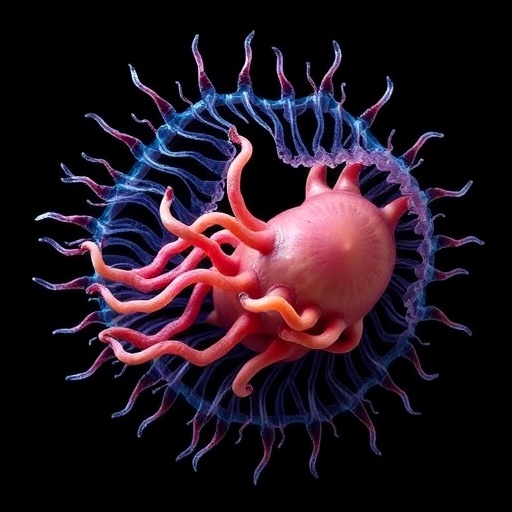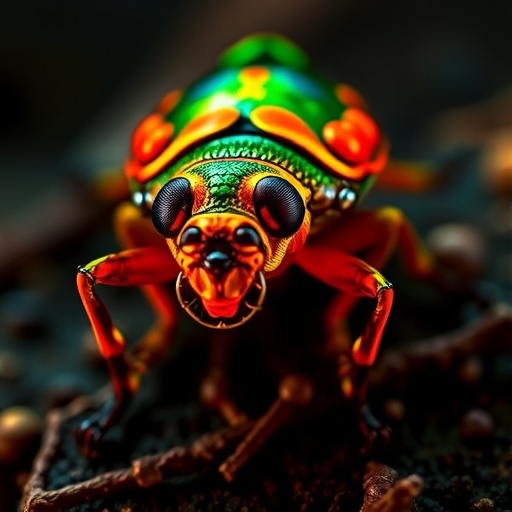
Deep within the enigmatic depths of the Bering Sea, researchers have uncovered insightful revelations regarding the male reproductive system of the thoroughly unique acorn worm species, Quatuoralisia malakhovi. This marine invertebrate not only contributes to our understanding of the biodiversity in this underexplored region but also offers clues about evolutionary adaptations in deep-sea organisms. The team, led by prominent biologists, has meticulously dissected this elusive creature to reveal complex anatomical structures that play a pivotal role in its reproductive strategy.
The acorn worm, belonging to the Hemichordata phylum and the Torquaratoridae family, is an organism that thrives in the challenging environment of the deep sea. Its unusual morphology and physiological characteristics reflect adaptations to extreme pressures and scarce food resources. These adaptations prompt scientists to investigate how such creatures reproduce and ensure the continuation of their lineage despite the hostile conditions surrounding them.
In their groundbreaking study published in Frontiers in Zoology, the authors devoted considerable effort to examining the male reproductive system of Quatuoralisia malakhovi. This research sheds light not only on the anatomy itself but also on the physiological processes that govern reproduction in deep-sea species. Through detailed histological analysis, the researchers observed strongly developed reproductive organs, which are indicative of the species’ success in reproducing under challenging environmental constraints.
The male reproductive system of Quatuoralisia malakhovi is characterized by specialized structures that facilitate gamete production and release. The complexity of these structures suggests a highly evolved system adapted to the demands of deep-sea life. Researchers noted that the testicular morphology plays a crucial role in the timing and manner in which sperm is produced and stored, presenting critical advantages for successful fertilization within the sparse populations found in the depths of the Bering Sea.
One remarkable feature of the reproductive anatomy identified in this study is the presence of a unique structure believed to assist in sperm motility. This adaptation is particularly noteworthy given the challenges faced in the nutrient-poor cold waters, where traditional movement mechanisms may fail. The analysis indicated that these structures could provide Quatuoralisia malakhovi with enhanced reproductive success against a backdrop of competition and environmental instability.
Moreover, this study explores the potential implications of such adaptations on the species’ evolutionary trajectory. Understanding how Quatuoralisia malakhovi has evolved mechanisms to thrive and reproduce in extreme environments could offer insights into the evolutionary pressures that shape deep-sea ecosystems. It raises questions about the genetic adaptability of marine organisms to climate change and habitat disturbances, highlighting the urgent need for further research in this area.
The ecological significance of acorn worms, especially in deep-sea environments, cannot be understated. They play a crucial role within their ecosystems, contributing to nutrient cycling and serving as a food source for various predators. The findings of this study provide a framework for understanding how reproductive strategies might influence the population dynamics of such pivotal species and, consequently, the health of the broader marine ecosystem.
As researchers continue to probe the depths of the Bering Sea, they may uncover additional aspects of biology that could elucidate how deep-sea organisms interact and coexist. The reproductive strategies of Quatuoralisia malakhovi, along with those of other sympatric species, may help scientists predict the responses of these populations to environmental shifts and additional anthropogenic stressors.
It is essential for marine biologists to bridge the gap between laboratory research and in-situ observations through comparative anatomy. Insights gained through this comprehensive investigation into the male reproductive system can extend to other hemichordates and even other marine invertebrates. This approach may ultimately enhance biodiversity conservation strategies, essential in maintaining the ecological balance of marine habitats.
The research team not only documented the reproductive anatomy but also emphasized the importance of in-depth species descriptions as vital for taxonomy and classification. As researchers refine the taxonomy of acorn worms and their relatives, they enhance our understanding of evolutionary relationships, which can be fundamental in tracking shifts in biodiversity and guiding conservation efforts.
For conservationists, the findings underscore the necessity of protecting such deep-sea habitats, which are often exploited for resources or affected by climate change. This research serves as a reminder of the hidden treasures within our oceans and the potential loss of invaluable biodiversity if these ecosystems are not prioritized for protection.
In summary, the work done by this research team encapsulates both the beauty and complexity of life in our oceans. As we learn more about organisms like Quatuoralisia malakhovi, we gain insights into the broader narratives of evolution and adaptation in one of Earth’s most mysterious realms. This research not only peels back the layers of deep-sea reproductive biology but also enriches the ongoing discourse on environmental sustainability and conservation.
Future studies may leverage these findings to explore genetic and environmental interactions that may shape reproductive strategies across a wider array of species. The road ahead is ripe with potential discoveries, promising a greater understanding of life in the abyss and the intricate ways organisms adapt and persist in extreme conditions.
The journey of understanding acorn worms and their reproductive systems is far from over, and that is where the intrigue lies. As the scientific community continues to explore our ocean depths, each revelation brings with it the promise of further insights into the elaborate tapestry of life on Earth.
Through continued exploration and research, we can foster a deeper appreciation of not only the acorn worm but all the marine organisms that play an essential role in sustaining our planet’s biodiversity and resilience.
Subject of Research: Male Reproductive System of the Deep-Sea Acorn Worm Quatuoralisia malakhovi
Article Title: Male reproductive system of the deep-sea acorn worm Quatuoralisia malakhovi (Hemichordata, Enteropneusta, Torquaratoridae) from the Bering Sea.
Article References:
Lukinykh, A.I., Ezhova, O.V., Yushin, V.V. et al. Male reproductive system of the deep-sea acorn worm Quatuoralisia malakhovi (Hemichordata, Enteropneusta, Torquaratoridae) from the Bering Sea. Front Zool 21, 26 (2024). https://doi.org/10.1186/s12983-024-00548-w
Image Credits: AI Generated
DOI: 10.1186/s12983-024-00548-w
Keywords: Deep-sea acorn worm, reproductive system, Hemichordata, evolutionary adaptations, Bering Sea.
Tags: Bering Sea biodiversitydeep-sea acorn worm reproductiondeep-sea organism reproduction strategiesevolutionary adaptations in marine invertebratesextreme environment physiological traitsFrontiers in Zoology publicationHemichordata phylum adaptationshistological analysis of marine speciesmale reproductive system anatomyQuatuoralisia malakhoviTorquaratoridae family characteristicsunique marine biodiversity research




